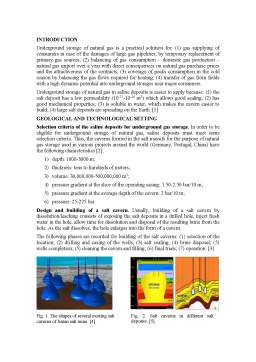Extras din referat
ABSTRACT
Natural gases represent the energy which can be stored in large quantities, in the same state as that in which it is used to the final consumer, without being subject to the transformations and disruption. One of the fundamental problems of gas industry is taking over the peaks of hourly and seasonal consumption, caused by the random nature of the gas demand, depending on the nature of the industrial consumers (with a relative constant gas demand) and those non-industrial (mainly household consumers with large hourly and seasonal fluctuations) and the possibilities of import, with approximately uniform and limited capabilities, in the period of day or all of the cold season.
The underground storage of natural gas represents a solution for gas supply of consumers in the case of damages to the pipelines, and the coverage of the peaks of consumption in cold season. Compensations for the required gas flows for heating are doing by transferring from the fields with a high dynamic potential in an underground storage near the big consumers.
The construction of the cavern in the saline deposits in view of the underground natural gas storage shall be made by the deep wells with direct or indirect circulation. By direct circulation, freshwater is injected through the working space with the smallest diameter, and the brine is evacuated in the annular space. The advantages of this method are: (1) eliminates the danger of dissolution of the salt from the surrounding area of the shaker of the last column cemented, due to the near-saturation concentration of ascended brine; (2) reducing the consumption of the insulating fluid given the lower cross-sectional diameter of the cavern ceiling; (3) performing a cavern of ovoid elongated shape with a maximum cross-sectional diameter at the base. By reverse circulation, freshwater is pumped in the annular space between the two casings, and the brine is evacuated in the casing with the smallest diameter. The advantage of this method is development of high ascending speeds in the inside of the casing with a small diameter, ensuring an efficient evacuation of insoluble material which will be deposited at the cavern bottom.
The underground gas storage in the saline deposits has the following advantages: (1) the large area of salt bodies spreading on the Earth; (2) the duration of the production process is few weeks, being possible to carry out several cycles per year; (3) the operating costs are lower than in the depleted reservoirs or aquifers.
In the paper the authors reviews some aspects regarding the underground storage of natural gas in the saline deposits in terms of selections criteria of salt cavern, designing, drilling technology, factors of stability, salt cavern deformation, production behavior.
Key words: saline deposits, underground gas storage, selection criteria, cavern designing and construction, stability and production behavior
INTRODUCTION
Underground storage of natural gas is a practical solution for: (1) gas supplying of consumers in case of the damages of large gas pipelines, by temporary replacement of primary gas sources, (2) balancing of gas consumption - domestic gas production - natural gas import over a year with direct consequences on natural gas purchase prices and the attractiveness of the contracts, (3) coverage of peaks consumption in the cold season by balancing the gas flows required for heating; (4) transfer of gas from fields with a high dynamic potential into underground storages near major consumers.
Underground storage of natural gas in saline deposits is easier to apply because: (1) the salt deposit has a low permeability (10-21-10-24 m2) which allows good sealing; (2) has good mechanical properties; (3) is soluble in water, which makes the cavern easier to build; (4) large salt deposits are spreading on the Earth. [1]
GEOLOGICAL AND TECHNOLOGICAL SETTING
Selection criteria of the saline deposits for underground gas storage. In order to be eligible for underground storage of natural gas, saline deposits must meet some selection criteria. Thus, the caverns formed in the salt massifs for the purpose of natural gas storage used in various projects around the world (Germany, Portugal, China) have the following characteristics [2]:
1) depth: 1000-3000 m;
2) thickness: tens to hundreds of meters;
3) volume: 30,000,000-500,000,000 m3;
4) pressure gradient at the shoe of the operating casing: 1.50-2.50 bar/10 m;
5) pressure gradient at the average depth of the cavern: 2 bar/10 m;
6) pressure: 25-225 bar.
Bibliografie
[1] Tongtao, W., Xiangzhen, Y., Henglin, Y., Xiujuan, Y., Tingting, J., Shuai, Z., A new shape design method of salt cavern used as underground gas storage, Applied Energy 104, pp. 50-61, 2013.
[2] Hilbert, L.B., Saraf, V.K., Salt Mechanics and Casing Deformation in Solution-Mined Gas Storage Operations, 42nd US Rock Mechanics Symposium, paper ARMA 08-383, pp. 1-12, San Francisco, 2008.
[3] Campbell, J.M., Gas Conditioning and Processing, Vol. I: The Basic Principles, Campbell Petroleum Series, Oklahoma, USA, 354 pp., 1993
[4] Shi, X.L., Yang, C.H., Li, Y.P., Li, J.L., Ma, H.L., Wang, T.T., Guo, Y.T., Development prospect of salt cavern gas storage and new research progress of salt cavern leaching in China, 51st US Rock Mechanics / Geomechanics Symposium, paper ARMA 17-626, pp. 1-10, San Francisco, 2017.
[5] Zhang, G.M., Li, Y.P., Daemen, J.J.K., Yang, C.H., Wu, Y., Zhang, K., Geotechnical feasibility analysis of compressed air energy storage (caes) in bedded salt formations: a case study in Huaian city, China, Rock Mechanics and Rock Engineering, vol. 48, issue 5, pp. 2111-2127, 2015.
[6] Medley, A.H., Storage of natural gas in salt caverns, Regional Gas Industry Symposium of the Society of Petroleum Engineers of AIME, Omaha, Nebraska, May 15-16, paper SPE-5427-MS, 1975.
[7] Dinu, F., Extracția si prelucrarea gazelor naturale, Editura Universității Petrol-Gaze din Ploiești,., 2013.
[8] Soare Al., Zamfirescu, M., Inmagazinarea gazelor naturale, Editura Universității Petrol-Gaze din Ploiești, 234 pp., 2005.
Preview document
Conținut arhivă zip
- Some aspects regarding the underground storage of natural gas in saline deposits.docx







